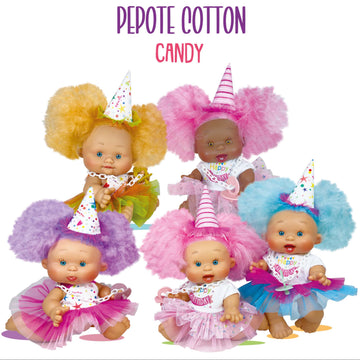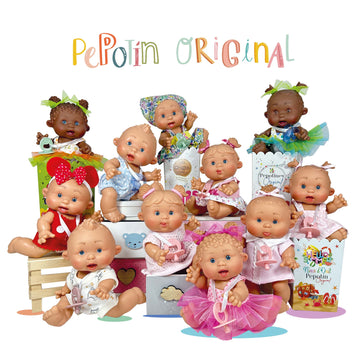Dolls And Accessories Things To Know Before You Buy
Dolls And Accessories Things To Know Before You Buy
Blog Article
See This Report on Dolls And Accessories
Table of ContentsDolls And Accessories Fundamentals ExplainedUnknown Facts About Dolls And AccessoriesThe smart Trick of Dolls And Accessories That Nobody is DiscussingDolls And Accessories Can Be Fun For EveryoneEverything about Dolls And AccessoriesThe 6-Minute Rule for Dolls And AccessoriesDolls And Accessories Fundamentals Explained
When dolls are included in group play, kids practice waiting, sharing, and listening to others' concepts. Whether they're pretending to be a parent, sibling, or pal, kids learn just how relationships workhow to sustain others, address differences, and look after another person. These very early role-play experiences end up being the groundwork for healthy and balanced friendships and partnerships later in life.Repeating comforting regimens with a doll (feeding, rocking, closing) can help youngsters feel calm and safe and secure. These soothing rituals show them how to self-regulate. Caring for a doll can make a kid feel qualified and confident - baby dolls. It provides a sense of responsibility and control in a world that frequently really feels unpredictable.
Little Known Questions About Dolls And Accessories.
When children see dolls that reflect their race, heritage, and culture, it reinforces a positive feeling of identification. It states, "You belong. Your tale issues." Dolls additionally introduce children to cultures outside their own, constructing considerate inquisitiveness and compassion for others. This is where inclusive play can bring about inclusive communities.
As Dr. Karyn Purvis, a leader in child development and trauma-informed treatment, when stated: This effective quote highlights just how play isn't just funit's exactly how kids find out ideal. The brain wires itself via rep. But when a kid is engaged, joyful, and emotionally attached to an activitylike doll playthe brain reinforces those links faster and more meaningfully.
The Dolls And Accessories PDFs

Children require compassion, kindness, and creativity tooand doll play offers that. Yesdolls supply something unique. They urge flexible narration and emotional link in a way few other toys do. Dolls are usually a kid's first "friend," assisting them exercise connections, develop communication abilities, and really feel comforted. Children develop their feeling of self from a young age.
The Ultimate Guide To Dolls And Accessories
Via dolls that matter. Samantha Ong Samantha Ong is the creator of Joeydolls, a Canadian-based toy brand on a goal to celebrate Asian cultures with happy, comprehensive play. Inspired by her own experiences growing up without social depiction, Samantha creates dolls that aid youngsters really feel happy of that they are while sparking inquisitiveness and empathy in others.
Playing with dolls motivates youngsters to speak even more concerning others' thoughts and emotions, a research has discovered. The study recommends that playing fictional games with dolls can aid kids create social abilities, theory of mind and compassion. The neuroscientist that led the job stated that the educational worth of having fun with Lego and building toys was commonly accepted, yet the advantages of having fun with dolls often showed up to have been forgotten."When children produce imaginary worlds and function play with dolls, they interact in the beginning out loud and afterwards internalise the message about others' thoughts, feelings and feelings," stated Dr Sarah Gerson, a neuroscientist at Cardiff College and the lead author.
Little Known Questions About Dolls And Accessories.
They were likewise more most likely to address the dolls in the 2nd person, speaking to them straight, whereas the characters on the computer display they often tended to describe in the 3rd person. No difference was observed between boys and women."Interior state language can show that a child is believing concerning other individuals's thoughts and emotions while playing with dolls," stated Gerson.
And that they see language use in this regard is excellent confirmation of the hypothesis."Mardell included that the searchings for ought to apply to any type of kind of role-play plaything, rather than being certain to Barbies."Kid generally begin to show indications of interior state language around the age of four.
The 15-Second Trick For Dolls And Accessories
"It becomes vital for making and sustaining friendships, and how they learn from their educators, and moms and dads."The research also located that the children had raised brain link activity in the posterior superior temporal sulcus (pSTS) area when they spoke as though their dolls had ideas and feelings. The pSTS area is believed to be included in the development of social and emotional processing abilities.
Childhood is not a static life phase; undoubtedly, the interpretation, meaning and understanding of childhood are all based on alteration. By the 19th century one of the most profound modifications was the value positioned on allowing children to experience "the carefree pleasures" of youth through play tasks. Play was now considered to be an essential part of a great childhood years.
In order to fully recognize the significance of play, one have to also recognize the importance of the doll. Dolls are a lot even more than playthings designed to entertain young ladies. Throughout the 19th century proper playtime tasks were selected to promote intellectual, physical or emotional advancement. Dolls were particularly prominent due to the fact that they were thought to foster and nurture womanly top qualities such as kindness, caring and concern.
The 10-Second Trick For Dolls And Accessories

It is just through historical examinations that scientists can intend to uncover and document the full variety of playtime experiences. Narrating these experiences, and particularly the duty of dolls, is essential for presenting a more full picture of childhood throughout the nineteenth century. Alarcn, Sara E - doll accessories., "Child's Play: The Duty of Dolls in 19th Century Childhood Years" (2007 )
Report this page